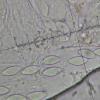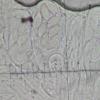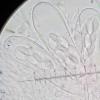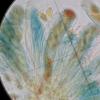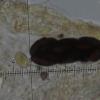
12-11-2021 00:03
Lepista ZacariasHi everybody,A week ago in my fiels trip I noticed

29-12-2025 17:44
Isabelle CharissouBonjour,J'aimerais savoir si d'autres personnes au

29-12-2025 17:12
 Bernard CLESSE
Bernard CLESSE
Bonjour à toutes et tous,Pourriez-vous m'aider à

29-12-2025 17:01
Gernot FriebesHi,I'm looking for help with this hyphomycete with

29-12-2025 08:30
Hello.A tiny ascomycete sprouting under Juniperus

29-12-2025 10:15
Hulda Caroline HolteHello, I found and collected this propoloid ascom

29-12-2025 09:38
Oskari VirtanenHi,could anyone help me identify this, I suspect P
Hello,
I found these violet frb on deer dung. Size up to 0,4mm. I see dark coloured tips of asci protruding above frb. Problem is that I see clustered brown (max 10%) spores and loose hyaline ones (90%). Which species could this be and which spores belong to the violet frb?
Loose spore in 8-spored J+asci, size 15/17x7/7,5µm, spores are smooth, without striae and thick walled (1µm), asci up to 21x130µm, paraphyses not swollen
Clustered spores: brown, 40/45x15/17
regards,
Ralph

you have a Saccobolus species there. The spores start off as free in the ascus and then by a wonderful phenomenon become united in a single 'spore-ball' the spores becoming pigmented as they mature. The pattern formed by the spores in the spore-ball is constant within a species.
Most of the spores in your images are immature. Do you have van Brummelen's 1967 monograph?
Cordialement
Chris

This is probably Saccobolus depauperatus; to comfirmed by other observations.
Michel.
Hello,
Thanks for the info. I don't think however it's depauperatus as average spore clusters are over 40µm long. Could it be versicolor?
PS I will check again because all terms of the key I use aren't clear to me.
regards,
Ralph

Hello Ralph,
It can be A. depauperatus but also A. versicolor it depends on the size of the spore cluster (your photo shows pattern III) and the single spores.
For A. depauperatus cluster is 28-37x10-13 um; single spores 10-14.5x5-7.5 um.
For A. versicolor cluster is 40-62x14-19 um; single spores 13-21.5x6.5-9.5 um.
Spores seem to be immature but when your measurement is correct I would go for A. versicolor. Also the size of the ascus does compare with A. versicolor in my opinion
Measuring cluster and spore sizes have been made easier with the software program that goes with the microscope camera, works for me.
Joop



